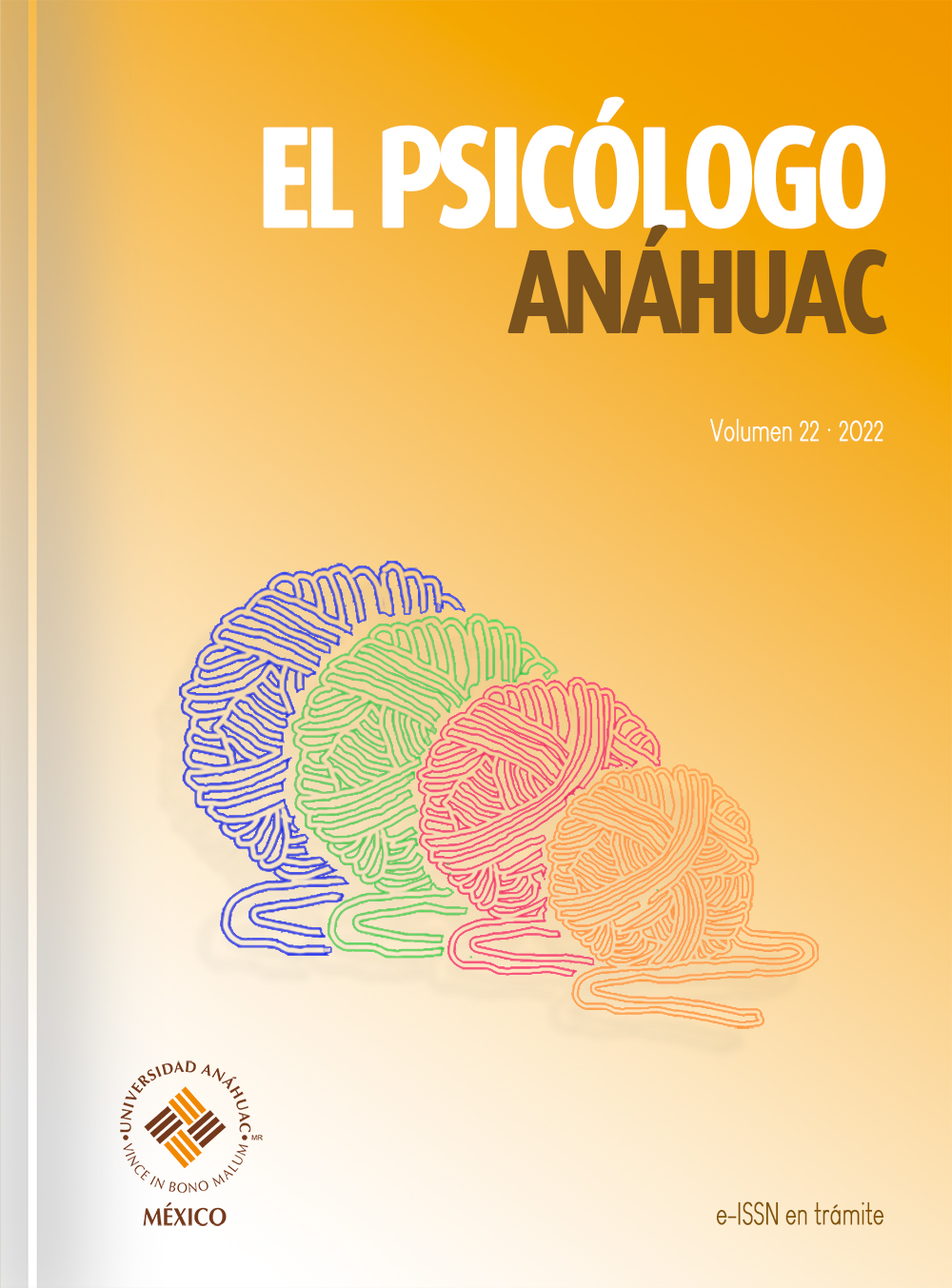Profiles of bystanders within the dynamics of school harassment (bullying)
DOI:
https://doi.org/10.36105/psic_anah.2022v22.05Keywords:
school harassment, bullying, teenager, bystanders of bullying, latent profilesAbstract
The purpose of the research was to identify the profiles of spectators in the dynamics of school harassment. Participants were 469 students (50.01% men and 49.9% women), between 12 and 16 years old (M = 13.6, DS = 1.03). Of the total number of students, 6.8% were classified as victims, 8.6% as bullies, 0.9% as bullies-victims and 83.7% as bystanders. An analysis of Latent Classes (ACL) was carried out to only identify the profiles of the bystanders, of which 21.5% were assistant of the victim, 32.9% were classified as indifferent, while the remaining 45.6% were defenders of the victim. From this information, the educational authorities can do the prevention and attention to school harassment in a differentiated way.
Downloads
References
Arias, W. (2014). ¿Qué es el Bullying?: Los actores, las causas y los principios para su intervención. Revista de Psicología de Arequipa, 4(1), 11-32. Recuperado de: https://www.researchgate.net/publication/275346100_
Arruga, A. (1992). Introducción al test sociométrico. Barcelona: Herder.
Baly, M., Cornell, D. & Lovegrove, P. (2014). A longitudinal investigation of self- and peer reports of bullying victimization across middle school. Psychology in the Schools, 51(3), 217-240. https://doi.org/10.1002/pits.21747
Babarro, J. M. (2014). Assessment and detection of peer-bullying through analysis of the group context. Psicothema, 26(3), 357-363. https://doi.org/10.7334/psicothema2014.85
Branson, C. & Cornell, D. (2009). A comparison of self and peer reports in the assessment of middle school bullying. Journal of Applied School Psychology, 25(1), 5-27. https://doi.org/10.1080/15377900802484133.
Brownell, C. & Gifford-Smith, M. (2003). Context and development in children's school-based peer relations: implications for research and practice. Journal of School Psychology, 41(4), 305-310. https://doi.org/10.1016/S0022-4405(03)00052-9
Camodeca, M., & Goossens, F. A. (2005). Children's opinions on effective strategies to cope with bullying: the importance of bullying role and perspective. Educational Research, 47(1), 93-105. https://doi.org/10.1080/0013188042000337587
Cerezo, F. (2001). Variables de personalidad asociadas en la dinámica bullying (agresores versus víctimas) en niños y niñas de 10 a 15 años. Anales de Psicología, 17(1), 37-43. Recuperado de: https://www.um.es/analesps/v17/v17_1/04-17_1.pdf
Cornell, D. & Cole, J. (2012). Assessment of bullying. En S. Jimerson, A. Nickerson, M. Mayer & M. Furlong (Eds.), The handbook of school violence and school safety: International research and practice (pp. 289-303). Mahwah, NJ: Routledge.
Cornell, D. & Brockenbrough, K. (2004). Identification of bullies and victims: A comparison of methods. Journal of School Violence, 3(2/3), 63-87. https://doi.org/10.1300/J202v03n02_05.
Crothers, L. & Levinson, E. (2004). Assessment of bullying: A review of methods and instruments. Journal of Counseling & Development, 82(4), 496-503. https://doi.org/10.1002/j.1556-6678.2004.tb00338.x
Cuevas, M. C., & Marmolejo, M. A. (2014). Observadores en situaciones de victimización por intimidación escolar: caracterización y razones de su rol. Psicología desde el Caribe, 31(1), 103-132. Recuperado de: https://www.redalyc.org/pdf/213/21330429006.pdf
Cullerton-Sen, C., & Crick, N. (2005). Understanding the effects of physical and relational victimization: The utility of multiple perspectives in predicting social-emotional adjustment. School Psychology Review, 34(2), 147-160. https://doi.org/10.1080/02796015.2005.12086280
Delfabbro, P., Winefield, T., Trainor, S., Dollard, M., Anderson, S., Metzer, J., & Hammarstrom, A. (2006). Peer and teacher bullying/victimization of South Australian secondary school students: Prevalence and psychosocial profiles. British Journal of Educational Psychology, 76(1), 71-90. https://doi.org/10.1348/000709904X24645.
Gini, G., & Pozzoli, T. (2006). The role of masculinity in children’s bullying. Sex Roles, 54(7-8), 585-588. https://doi.org/10.1007/s11199-006-9015-1
Gómez, A. (2013). Bullying: El poder de la violencia. Una perspectiva cualitativa sobre acosadores y víctimas en escuelas primarias de Colima. Revista Mexicana de Investigación Educativa, 18(58), 839-870. Recuperado de: http://www.scielo.org.mx/pdf/rmie/v18n58/v18n58a8.pdf
Graham, S., Bellmore, A., & Juvonen, J. (2003). Peer victimization in middle school: When self- and peer views diverge. Journal of Applied School Psychology, 19(2), 117-137. https://doi.org/10.1300/J008v19n02_08
Graham, S., Bellmore, A., & Mize, J. (2006). Peer victimization, aggression, and their co-occurrence in middle school: Pathways to adjustment problems. Journal of Abnormal Child Psychology, 34(3), 349-364. https://doi.org/10.1007/s10802-006-9030-2
Iossi, M. A., Pereira, B., Mendonça, D., Nunes, B. & Wanderlei A.d. (2013). The involvement of girls and boys with bullying: An analysis of gender differences. International Journal of Environmental Research and Public Health, 10(12), 6820-6831. https://doi.org/10.3390/ijerph10126820
Jaradat, A. (2017). Gender differences in bullying and victimization among early adolescents in Jordan. PEOPLE: International Journal of Social Sciences, 3(3), 440-451. https://doi.org/10.20319/pijss.2017.33.440451
Jimerson, S., Swearer, S., & Espelage, D. (2009). Handbook of bullying in schools: An international perspective. Nueva York: Routledge.
Jenkins, L., & Nickerson, A. (2017). Bullying participant roles and gender as predictors of bystander intervention. Aggressive Behavior, 43(3), 281-290. https://doi.org/10.1002/ab.21688
Juvonen, J., Wang, Y., & Espinoza, G. (2011). Bullying experiences and compromised academic performance across middle school grades. Journal of Early Adolescence, 31(1), 152-173. https://doi.org/10.1177/0272431610379415
Kärnä, A., Voeten, R., Poskiparta, E., & Salmivalli, C. (2010). Vulnerable children in varying classroom contexts: Bystanders’ behaviors moderate the effects of risk factors on victimization. Merrill-Palmer Quarterly, 56(3), 261-282. https://doi.org/10.1353/mpq.0.0052
Lodge, J., & Frydenberg, E. (2005). The role of peer bystanders in school bullying: Positive steps toward promoting peaceful schools. Theory Into Practice, 44(4), 329-336. https://doi.org/10.1207/s15430421tip4404_6
Marín-Martínez, A., & Reidl, L. M. (2013). Validación psicométrica del cuestionario “Así nos llevamos en la escuela” para evaluar el hostigamiento escolar (bullying) en primarias. Revista Mexicana de Investigación Educativa, 18(56), 11-36. Recuperado de: http://www.scielo.org.mx/scielo.php?pid=S1405-66662013000100002&script=sci_abstract
Marini, Z., Dane, A., & Bosacki, S. (2006). Direct and indirect bully-victims: differential psychosocial risk factors associated with adolescents involved in bullying and victimization. Aggressive Behavior, 32(6), 551-569. https://doi.org/10.1002/ab.20155
Nordhagen, R., Nielsen, A., Stigum, H., & Köhler, L. (2005). Parental reported bullying among Nordic children: a population-based study. Child: Care, Health & Development, 31(6), 693-701. https://doi.org/10.1111/j.1365-2214.2005.00559.x
Obermann, M. L. (2013). Temporal aspects of moral disengagement in school bullying: crystallization or escalation? Journal of School Violence, 12(2), 193-210. https://doi.org/10.1080/15388220.2013.766133
Olweus, D. (1993). Bullying at school: what we know and what we can do. Malden, MA: Blackwell Publishing.
Ortega, R. (1998). La convivencia escolar: qué es y cómo abordarla. Programa educativo de prevención del maltrato entre compañeros y compañeras. Sevilla: Consejería de Educación y Ciencia, Junta de Andalucía. Recuperado de: https://creena.educacion.navarra.es/web/bvirtual/2018/06/01/la-convivencia-escolar-que-es-y-como-abordarla/
Österman, K., Björkqvist, K., Lagerspetz, K., Kaukiainen, A., Huesmann, L. R., & Frączek, A. (1994). Peer and self-estimated aggression and victimization in 8-year-old children from five ethnic groups. Aggressive Behavior, 20(6), 411-428.
Pellegrini, A., & Bartini, M. (2000). An empirical comparison of methods of sampling aggression and victimization in school settings. Journal of Educational Psychology, 92(2), 360-366. https://doi.org/10.1037/0022-0663.92.2.360.
Phillips, V., & Cornell, D. (2012). Identifying victims of bullying: Use of counselor interviews to confirm peer nominations. Professional School Counseling, 15(3), 123-131. https://doi.org/10.5330/PSC.n.2012-15.123
Rolider, A., & Ochayon, M. (2005). Bystander behaviours among Israeli children witnessing bullying behaviour in school settings. Pastoral Care in Education, 23(2), 36-39. https://doi.org/10.1111/j.0264-3944.2005.00330.x
Santoyo, D., & Frías, S. (2014). Acoso escolar en México: actores involucrados y sus características. Revista Latinoamericana de Estudios Educativos, 44(4), 13-41. Recuperado de: http://www.redalyc.org/pdf/270/27032872002.pdf
Salmivalli, C. (1998). Intelligent, attractive, well-behaving, unhappy: The structure of adolescents' self-concept and its relations to their social behavior. Journal of Research on Adolescence, 8(3), 333-354. https://doi.org/10.1207/s15327795jra0803_3
Salmivalli, C., Lagerspetz, K., Björkqvist, K., Österman, K., & Kaukialnen, A. (1996). Bullying as a group process: Participant roles and their relations to social status within the group. Aggressive Behavior, 22(1), 1-15. https://doi.org/10.1002/(SICI)1098-2337(1996)22:1<1::AID-AB1>3.0.CO;2-T
Schwartz, D., Dodge, K., Pettit, G., & Bates, J. (1997). The early socialization of aggressive victims of bullying. Child Development, 68(4), 665-675. https://doi.org/10.2307/1132117.
Strohmeier, D., Spiel, C., & Gradinger, P. (2008). Social relationships in multicultural schools: Bullying and victimization. European Journal of Developmental Psychology, 5(2), 262-285. https://doi.org/10.1080/17405620701556664
Warden, D., & Mackinnon, S. (2003). Prosocial children, bullies and victims: An investigation of their sociometric status, empathy and social problem-solving strategies. British Journal of Developmental Psychology, 21(3), 367-385. https://doi.org/10.1348/026151003322277757
Waasdorp, T. E., & Bradshaw, C. (2018). Examining variation in adolescent bystanders' responses to bullying. School Psychology Review, 47(1), 18-33. https://doi.org/10.17105/SPR-2017-0081.V47-1
Yoneyama, S., & Rigby, K. (2006). Bully/victim students and classroom climate. Youth Studies Australia, 25(3), 34-41.
Zurita, Ú. (2012a). Concepciones e implicaciones de tres leyes antibullying en México. Diálogos sobre educación. Temas actuales en investigación educativa, 4(3), 21 p. Recuperado de: http://dialogossobreeducacion.cucsh.udg.mx/index.php/DSE/article/view/362
Zurita, Ú. (2012b). Las escuelas mexicanas y la legislación sobre la convivencia, la seguridad y la violencia escolar. Revista Educación y Territorio, 2(1), 19-36. Recuperado de: https://www.jdc.edu.co/revistas/index.php/reyte/article/view/411
Downloads
Published
How to Cite
Issue
Section
License

This work is licensed under a Creative Commons Attribution-NonCommercial-ShareAlike 4.0 International License.
El Psicólogo Anáhuac is distributed under a Licencia Creative Commons Atribución-NoComercial-CompartirIgual 4.0 Internacional.
The author keeps the property rights with no restriction whatsoever and guarantees the magazine the right to be the first publication of the work. The author is free to deposit the published version in any other medium, such as an institutional archive or on his own website.















